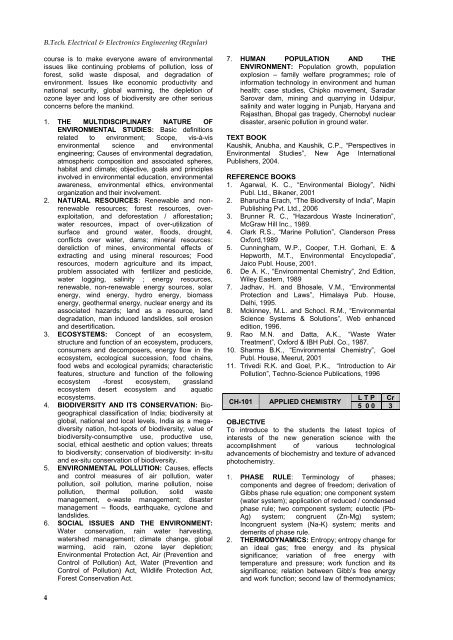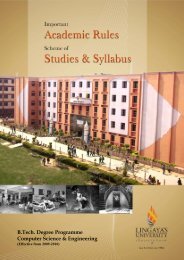Electrical and Electronics - Lingaya's University
Electrical and Electronics - Lingaya's University
Electrical and Electronics - Lingaya's University
Create successful ePaper yourself
Turn your PDF publications into a flip-book with our unique Google optimized e-Paper software.
B.Tech. <strong>Electrical</strong> & <strong>Electronics</strong> Engineering (Regular)course is to make everyone aware of environmentalissues like continuing problems of pollution, loss offorest, solid waste disposal, <strong>and</strong> degradation ofenvironment. Issues like economic productivity <strong>and</strong>national security, global warming, the depletion ofozone layer <strong>and</strong> loss of biodiversity are other seriousconcerns before the mankind.1. THE MULTIDISCIPLINARY NATURE OFENVIRONMENTAL STUDIES: Basic definitionsrelated to environment; Scope, vis-à-visenvironmental science <strong>and</strong> environmentalengineering; Causes of environmental degradation,atmospheric composition <strong>and</strong> associated spheres,habitat <strong>and</strong> climate; objective, goals <strong>and</strong> principlesinvolved in environmental education, environmentalawareness, environmental ethics, environmentalorganization <strong>and</strong> their involvement.2. NATURAL RESOURCES: Renewable <strong>and</strong> nonrenewableresources; forest resources, overexploitation,<strong>and</strong> deforestation / afforestation;water resources, impact of over-utilization ofsurface <strong>and</strong> ground water, floods, drought,conflicts over water, dams; mineral resources:dereliction of mines, environmental effects ofextracting <strong>and</strong> using mineral resources; Foodresources, modern agriculture <strong>and</strong> its impact,problem associated with fertilizer <strong>and</strong> pesticide,water logging, salinity ; energy resources,renewable, non-renewable energy sources, solarenergy, wind energy, hydro energy, biomassenergy, geothermal energy, nuclear energy <strong>and</strong> itsassociated hazards; l<strong>and</strong> as a resource, l<strong>and</strong>degradation, man induced l<strong>and</strong>slides, soil erosion<strong>and</strong> desertification.3. ECOSYSTEMS: Concept of an ecosystem,structure <strong>and</strong> function of an ecosystem, producers,consumers <strong>and</strong> decomposers, energy flow in theecosystem, ecological succession, food chains,food webs <strong>and</strong> ecological pyramids; characteristicfeatures, structure <strong>and</strong> function of the followingecosystem -forest ecosystem, grassl<strong>and</strong>ecosystem desert ecosystem <strong>and</strong> aquaticecosystems.4. BIODIVERSITY AND ITS CONSERVATION: Biogeographicalclassification of India; biodiversity atglobal, national <strong>and</strong> local levels, India as a megadiversitynation, hot-spots of biodiversity; value ofbiodiversity-consumptive use, productive use,social, ethical aesthetic <strong>and</strong> option values; threatsto biodiversity; conservation of biodiversity: in-situ<strong>and</strong> ex-situ conservation of biodiversity.5. ENVIRONMENTAL POLLUTION: Causes, effects<strong>and</strong> control measures of air pollution, waterpollution, soil pollution, marine pollution, noisepollution, thermal pollution, solid wastemanagement, e-waste management; disastermanagement – floods, earthquake, cyclone <strong>and</strong>l<strong>and</strong>slides.6. SOCIAL ISSUES AND THE ENVIRONMENT:Water conservation, rain water harvesting,watershed management; climate change, globalwarming, acid rain, ozone layer depletion;Environmental Protection Act, Air (Prevention <strong>and</strong>Control of Pollution) Act, Water (Prevention <strong>and</strong>Control of Pollution) Act, Wildlife Protection Act,Forest Conservation Act.7. HUMAN POPULATION AND THEENVIRONMENT: Population growth, populationexplosion – family welfare programmes; role ofinformation technology in environment <strong>and</strong> humanhealth; case studies, Chipko movement, SaradarSarovar dam, mining <strong>and</strong> quarrying in Udaipur,salinity <strong>and</strong> water logging in Punjab, Haryana <strong>and</strong>Rajasthan, Bhopal gas tragedy, Chernobyl nucleardisaster, arsenic pollution in ground water.TEXT BOOKKaushik, Anubha, <strong>and</strong> Kaushik, C.P., ―Perspectives inEnvironmental Studies‖, New Age InternationalPublishers, 2004.REFERENCE BOOKS1. Agarwal, K. C., ―Environmental Biology‖, NidhiPubl. Ltd., Bikaner, 20012. Bharucha Erach, ―The Biodiversity of India‖, MapinPublishing Pvt. Ltd., 20063. Brunner R. C., ―Hazardous Waste Incineration‖,McGraw Hill Inc., 1989.4. Clark R.S., ―Marine Pollution‖, Cl<strong>and</strong>erson PressOxford,19895. Cunningham, W.P., Cooper, T.H. Gorhani, E. &Hepworth, M.T., Environmental Encyclopedia‖,Jaico Publ. House, 2001.6. De A. K., ―Environmental Chemistry‖, 2nd Edition,Wiley Eastern, 19897. Jadhav, H. <strong>and</strong> Bhosale, V.M., ―EnvironmentalProtection <strong>and</strong> Laws‖, Himalaya Pub. House,Delhi, 1995.8. Mckinney, M.L. <strong>and</strong> Schocl. R.M., ―EnvironmentalScience Systems & Solutions‖, Web enhancededition, 1996.9. Rao M.N. <strong>and</strong> Datta, A.K., ―Waste WaterTreatment‖, Oxford & IBH Publ. Co., 1987.10. Sharma B.K., ―Environmental Chemistry‖, GoelPubl. House, Meerut, 200111. Trivedi R.K. <strong>and</strong> Goel, P.K., ―Introduction to AirPollution‖, Techno-Science Publications, 1996CH-101APPLIED CHEMISTRYL T P Cr5 0 0 3OBJECTIVETo introduce to the students the latest topics ofinterests of the new generation science with theaccomplishment of various technologicaladvancements of biochemistry <strong>and</strong> texture of advancedphotochemistry.1. PHASE RULE: Terminology of phases;components <strong>and</strong> degree of freedom; derivation ofGibbs phase rule equation; one component system(water system); application of reduced / condensedphase rule; two component system; eutectic (Pb-Ag) system; congruent (Zn-Mg) system;Incongruent system (Na-K) system; merits <strong>and</strong>demerits of phase rule.2. THERMODYNAMICS: Entropy; entropy change foran ideal gas; free energy <strong>and</strong> its physicalsignificance; variation of free energy withtemperature <strong>and</strong> pressure; work function <strong>and</strong> itssignificance; relation between Gibb‘s free energy<strong>and</strong> work function; second law of thermodynamics;4
















